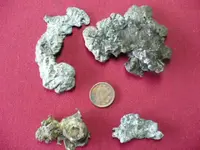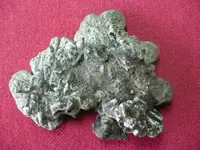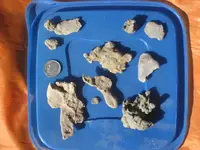Nuggets4me,
The top two pieces are most likely melted lead, or lead alloy, based on the description and accompanying photos. Considering the left piece weighs around
1/4 pound, and the one on the right weighs even more, could rule out a lightweight metal such as aluminum. Additionally, aluminum will actually burn at high temperature rather than simply melting, resulting in spots of crispy charred material opposed to uniformly smooth melted material. In many areas where silver has been mined, the ore would sometimes be found in the form of a natural lead sulfide known as galena. I've seen and recovered melted lead/silver, that had been crudely smelted, from around mining areas in Colorado, Utah, and Nevada. The areas near Idyllwild, as well as around San Jacinto, San Gorgonio, and surrounding regions, are historically noted more for yellow
oro, than the lesser value white
plata metal. Therefor, crudely smelted and melted galena containing silver can likely be ruled out due to geographic and geologic location.
If I'm not mistaken, the coin in the middle for size reference, appears to be a coronet type U.S. large cent 1837-1857, or is it a gold coin?

A "half cent" of similar design and era also, would change our viewpoint slightly on actual size reference.

The bottom two pieces appear slightly different in color and composition. There is the possibility they may be comprised of a different metallic alloy than the two larger pieces.
My own early years of exploring old mines and searching for treasures, actually began in the deserts of Southern California a few decades ago. 8) The recovery of large globs of metal in the high mountains or dusty desert can certainly cause the heart to skip a beat.

CC Hunter
 Just curious what the heck it might be....
Just curious what the heck it might be.... Just curious what the heck it might be....
Just curious what the heck it might be....







 I may have another post here pretty soon. We found something today that looks like gold
I may have another post here pretty soon. We found something today that looks like gold  and I would love to have everyone's opinion. I can't wait to hear what you guys have to say. To be continued...
and I would love to have everyone's opinion. I can't wait to hear what you guys have to say. To be continued... 
